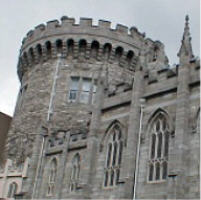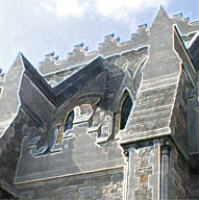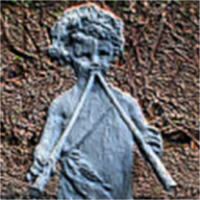|
John Bunyan And Pilgrim's Progress
John Bunyan is one of the most famous Christians in world history! His greatest work, ‘Pilgrim's Progress’ is still
famous today - it was written in 1678!
He fought for the true expression of the Christian faith in England, opposed the false doctrines of the Catholic
Church and rejected its powerful political influences. He suffered greatly for his faith, spent years in prison
and yet overcame, leaving a wonderful legacy to the Christian world!
The Early Years
John Bunyan was born in November 1628 at Elstow, Bedfordshire, England and was the son of Thomas Bunyan, a poor
brazier or tinker and Margaret Bentley (Thomas’s second wife). In November 1644 Bunyan, at just sixteen enlisted
in the Parliamentary army, joining with the Newport Pagnell garrison, which in 1645 moved to Leicester. In August
1646, the order was given that the Newport Pagnell garrison was to be disbanded and the soldiers were to be “employed
for the service of Ireland.” Bunyan joined up but in 1647 returned home from Ireland.
|
|

|
Marriage
In either 1647 or 1648 Bunyan married his first wife Mary, who tried to change his un-spiritual way of life and
influenced him greatly. She was an orphan and by 1650 they had a daughter called Mary who was blind. In total
they had four children together, John, Thomas, Mary and Elizabeth. Writing in ‘Grace Abounding’ Bunyan said, “I
changed my condition into a married state, and my mercy was to light upon a wife whose father was counted godly.
This woman and I, though we came together as poor as poor might be, not having so much household stuff as a dish
or spoon between us both, yet this she had for her part, the plain man’s pathway to heaven, and the practice of
piety, which her father had left her when he died.”
Conversion
In the 1650’s, Bunyan served for a time in the Parliamentary Army, during the English Civil War. The Republican
Government ruled from (1649-1660), the House of Lord’s was abolished, as was the Anglican Church.
In 1651, whilst in Bedford, Bunyan came into contact with an Independent congregation and after several years of
soul searching and inner turmoil, he experienced the saving grace of the Almighty God and bowed the knee to Jesus.
In Bunyan’s Bible it was written, “This book will keep you from sin, or sin will keep you from this book.”
Bunyan wrote, “God has set a Saviour against sin, a heaven against a hell, light against darkness, good against
evil, and the breadth and length and depth and height of grace that is in Himself for my good, against all
the power and strength and subtlety of every enemy.”
The Republican Government
On 12 December 1653, after Cromwell had refused an offer of the Crown, Cromwell, (virtual dictator of England from
1649-1658) received the title of Lord Protector. He used his office to seek reforms in the Church and
Parliament, which was a common aim of the Puritans. He tried to get 140 devout churchmen to run the country, but
it did not work, so after five months they handed power back to Cromwell. When Cromwell died his son Richard
(in September 1658), was proclaimed Lord Protector of the Realm, but he was not up to the job and senior army
commanders quarrelled amongst themselves. The military officers on the council showed open animosity towards
their civil counterparts and resented his appointment. Richard was forced to dissolve the Protectorate and
reinstate the Rump Parliament in January 1659.Total anarchy was avoided by a decision to return to the ancient
constitution of Kings, Lords and Commons.
|

|
|
Started Writing
In 1655, Bunyan joined a Bedford Independent Congregation, St John’s Church and became a deacon and was fully committed
to preaching the gospel. His wife, Mary died in the same year. In 1656, Bunyan published his first work entitled,
“Some Gospel Truths Opened” and the following year, he was formally recognised as a preacher. Bunyan went on to
write over sixty works - which included allegories, sermons, and poetry in all of which he tried to point individuals to
Jesus Christ.
In 1658 an indictment was brought against Bunyan for “Preaching at Eaton Socon” but the charge appears to have
been dropped. In 1659 Bunyan married for the second time, a woman called Elizabeth.
|
Puritan Preacher
John Bunyan was a Puritan, an extreme Protestant in Britain, who was dissatisfied with mere religion and wanted
further purification of the established church from its unscriptural and corrupt forms. Many of the Churches of
England were still styled on the Roman Catholic form, but the Puritans wanted an organisation modelled on the
Continental Protestantism, especially the model of Geneva. The Republican Government was in power and as the
Anglican Church was abolished the Dissenters were ‘free’ to worship and order their services how they felt led
to or were comfortable with. John Bunyan, like most Puritans in his day read the Bible through the eyes of the
Apostle Paul. He believed that nothing mattered, but the saving of the soul. The contrast between the terrors
of the law and freedom and joy brought by grace is complete. Bunyan shows the strength of the early nonconformity.
In Prison
In November 1660, after the restoration of the English government, Bunyan was arrested and placed in Bedford prison
and charged with “devilishly and perniciously abstaining from coming to Church to hear divine service, and for being
a common upholder of several unlawful meetings and conventicles, to the great disturbance and distraction of the good
subjects of this kingdom, contrary to the laws of our sovereign Lord and King.” Unlicensed preachers and Catholics
were a thorn in the side of government who regarded them as something akin to traitors.
Within a few weeks of his incarceration without trial Elizabeth, Bunyan’s second wife gave birth to a still-born
child after being in labour for eight days. In 1661, Elizabeth went before the judge to ask that her husband’s
case be re-considered but she was denied. In 1662, Bunyan tried to have his name entered in the calendar of
offenders, so his case would come before the judges but the Clerk of the Peace altered Bunyan’s entry, thus
making it possible for Bunyan to remain in prison for the next four years. It was not until 1679, when the Habeas
Corpus Act was passed in Britain, which demanded that the prisoner must be brought before the courts, and not
unlawfully detained.
|

|
|
Taunted In Prison
When John Bunyan’s enemies said to him, ‘Promise not to preach and you can leave the prison today,’ he replied, if you
let me go today, I shall preach again tomorrow’; like the Apostle Paul who said, ‘Woe to me if I do not preach the
gospel.’ When Bunyan’s friends visited, they often left him feeling low. ‘What about your wife and children; who
has to take care of them?’ his friends said and what in particular, about Mary?’ - his blind daughter. Bunyan used
to go to his knees asking God to keep him faithful in this trying situation.
In around 1664 Bunyan published, “One thing is Needful” on single sheets to be sold by his wife and children, to aid
them financially.
|
King Charles II
Charles II of the House of Stuart, was king of England, from April 1661-1685. In his earlier attempts at winning
the throne, he had courted the Scots Presbyterians, but in later life, he reverted to his Catholic preferences.
There were many Protestant denominations: Baptists, Congregationalists and Quakers; all of them refused to conform
to the Act of Uniformity of 1662. Action against them came in the form of the Clarendon Code 1664-5, a collection
of restrictive measures that stopped from professional advancement in all the professions, except business.
In 1664, the Conventicle Act against the nonconformist Christians forbade the holding of meetings of five or more
persons. In 1665, the Five Mile Act put restrictions on nonconformist ministers and the plague hit London
killing 100,000 persons.
Bunyan’s Books
Bunyan was incarcerated for much of the time from 1660-1672, in deplorable conditions, but spent his time wisely
in writing more Christian books, sermons and poems, some of which are now regarded as Christian classics. His
spiritual autobiography, ‘Grace Abounding to the Chief of Sinners’ was written in 1666. It was in the same year
as the Great Fire of London. Bunyan was released for a short period of time but then re-incarcerated for
another six years.
Pilgrim's Progress
In 1678, John Bunyan wrote the famous, ‘Pilgrim's Progress’ on milk churn lids; it is an allegory of the Christian
life based on Bunyan’s own walk and was published in the same year. In the book the main character ‘Christian’
was on his travels to the shining city and meets such characters as Evangelist, Faithful, Pliable, the Giant of
Despair, and Discouragement. Christian’s epic hazardous journey takes him from the City of Destruction, through
the Slough of Despond, to the foot of the cross, then on through the Valley of Shadow, Vanity Fair and all its
gaiety, Doubting Castle and many others till he finally reaches his home-coming and crosses the river to reach
the shining city.
Bunyan’s Freedom
After 1668, King Charles II began to turn more and more toward the Catholic religion. He concluded treaties with
Louis XIV of France and agreed to reconcile himself with the Church of Rome. In 1672, he issued a Declaration
of Indulgence, allowing freedom of religion for Catholics, as well as for non-conformists known as Dissenters. This
gave Bunyan the freedom he had deserved and so along with myriads of others was duly released. His formal pardon
is dated 13th September 1672, but he received a royal licence to preach five months previously. The passing of the
Test Act of 1673 compelled public office holders to take the sacrament of the Church of England. Catholics were
hunted down and killed, and the legitimate heir, James Duke of York, was excluded from the throne by Parliament
because he was a Catholic.
Bunyan’s Final Years
Bunyan was jailed again briefly in 1676 and on his release resumed his pastorate in Bedford. In 1682, Bunyan wrote
his book ‘The Holy War’ which uses wartime images to construct another allegory. The book is very complex, and
mixes personal and cosmic events. Charles II died of a heart attack in February 1685. In the same year ‘Pilgrim's
Progress’ went into its tenth edition.
James II King of England (who reigned from 1685-1688) attempted to re-introduce Roman Catholicism into a country that had
become Protestant, yet he recognised the Church of England as the established church.
The Declaration of Indulgence of 1687 aimed at complete religious toleration that furthered the resentment of the
nation’s Protestant majority. Non-conformists and Anglicans reformed their alliance against the religious policies
of the king. Due to an invasion King James II escaped, so that William and Mary, in a joint monarchy, became rulers
of Britain. James II and his baby son were debarred from the succession, as were all Catholics.
In 1688 on the 19th August, Bunyan aged sixty, preached his last sermon and after catching a sever cold, endured
ten days of fever and passed into glory on the 31st August 1688. John Bunyan was buried in Bunhill Fields, London
and his tomb can still be seen there today.
|
|